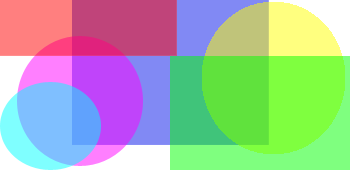I was in a class the other day and the teacher tried to get across the idea that mixing colors onscreen is different from mixing colors using actual paint. The paints mixed together makes a brown mess, while mixing colors onscreen makes white.
Is anyone else confused about this?
The Short Explanation
Paint absorbs light, while computer monitors create it.
Paint:
Paint absorbs some light and reflects other light. The light it reflects hits our eyes.
SO:Â When light hits blue paint, most of the colors are absorbed and mainly blue light is reflected to your eyes. You see blue.
Red paint reflects mainly red light and absorbs the rest. Green paint reflects mainly green light. I think you get the point.
Let’s mix all those colors
Mix them up. The red paint still absorbs most of the blue and green light. The blue paint absorbs most of the red and green light. The green paint absorbs most of the red and blue light.
Hmm. That doesn’t leave much, does it? When we mix all the colors in paint, we get a mushy, ugly, brown, because no clear colors are being reflected to our eyes.
Paint: mixing all colors = very little color hitting our eyes (we see brown-black)
Screen:
Here, we’re creating light, not reflecting light that was emitted elsewhere. When the screen shows red, it’s emitting red light. There’s nothing being absorbed.
What does this mean?
Let’s mix all those colors
We tell our paint program to show us full red, green, and blue. Now we’re adding to, not subtracting from, the light that reaches your eyes. It’s red plus green plus blue. The mix of all those colors comes to eyes as white.
Screen: mixing all colors = lots of color hitting our eyes (white)
And that about covers it. Or, I hope it does. And now, just for fun…
A Word about Color
Color (and light itself) is the way our eyes and brains interpret different electromagnetic wavelengths. (I promise that’s the last time I’ll say “electromagnetic” in this post.)
When the wavelengths are within a range that our eyes and brains can interpret, we call it visible light. (Radio waves, gamma rays, x-rays, and microwaves are all the same stuff, but at different wavelengths.)
When light has a shorter wavelength, it looks a little more blue. Longer wavelengths look a litter more red. Ultraviolet burns our skin, but the waves are too short for humans to see. Infrared shows up on those awesome military goggles, but otherwise the waves are too long.
Different things reflect and absorb different wavelengths. Black absorbs most of it, while white reflects most of it.
It’s interesting to me that a paint that we CALL green (let’s say) is actually reflecting green. That is, there’s nothing really green about the paint itself. It hates green light and loves other colors. But we call it green, poor thing.
Does this make sense? Does everyone already know this stuff? Does it help you in any way, or is it completely unnecessary? and also, did I get it right? I’m a writer, you know, not a designer or artist, so let me know!


This was very helpful. I did not know enough about color to know there was such a difference. Do you have any thing you can share with us on the differences between RGB, HSL, and the other types of color designations (or whatever they are called) that we find in PowerPoint and in website and blog software?
I like that you put these subjects in terms writers can understand.
Thanks, Bob. I can’t really talk about the differing systems, except to say that CMYK means Cyan, Magenta, Yellow, and Black (or Key color).
I know that print stuff uses CMYK over RGB. But I don’t know why! Hey, if you find out, let me know!
I hadn’t thought about the fact that computer screens shoot the colors at our eyes, creating the light.
However, I have thought about the last point you raised. Basically, something we say is green isn’t really green; it just looks green. It’s really everything but green. 🙂
Ben, I often try to think about why something is a color. For example, why are leaves green? I know that they absorb energy from the sun, but they must be absorbing only the high energy (blue) rays and the low energy (red) ones. I love that stuff.